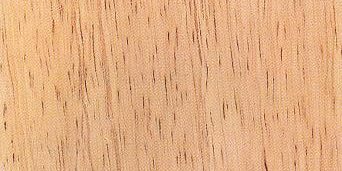Machang Wood
INTRODUCTION
The Standard Malaysian Name for the wood of Mangifera spp. (Anacardiaceae). Many vernacular names for the species of this genus have been recorded and they include asam (Sabah) with various epithets, bachang (Peninsular Malaysia and Sarawak), lanjut (Peninsular Malaysia), figured asam (Sabah), machang api (Peninsular Malaysia), machang hutan (Peninsular Malaysia), mangga (Peninsular Malaysia), mempelam (Peninsular Malaysia), pauh (Peninsular Malaysia), rawa (Peninsular Malaysia) and other localised names too numerous to list here. Major forest species of Mangifera include M. applanata, M. caesa, M. foetida, M. griffithii, M. indica, M. longipetiolata, M. laurina, M. odorata, M. pajang, M. parviflora, M. quadrifida and M. torquenda. The sapwood is not clearly defined from the heartwood, which is light pink-brown to light brown. In many trees, a streaky corewood is produced, where the wood is dark brown interspersed with streaks of blacks. This figured material is usually with a natural sheen.
Also known as Pacific walnut (Australia); Machang (Brunei); Svay prey (Cambodia); Mangga and Mango (India); Mangga hutan and Membacang (Indonesia); Thayet (Myanmar); Magga and Mango (Pakistan); Malapaho, Paho and Pahutan (Philippines); Ailai and Asai (Soloman Islands); Estamba (Sri Lanka); Ma Muang Pa and Mamuang (Thailand); and Xoan tia (Vietnam).
DENSITY
The wood is a Light Hardwood with a density of 545-610 kg/m3 air dry.
NATURAL DURABILITY
The wood is moderately durable to non-durable under exposed conditions. Under graveyard test conditions, untreated specimens of M. foetida (50 mm x 50 mm x 600 mm) lasted only up to two years. The wood is subjected to subterranean termite and fungal attacks. Treated specimens of the same size and species were planted in the graveyard test site and after 22 years, 60% of the specimens have been destroyed (Tam, 1982).
PRESERVATIVE TREATMENT
This wood is classified as very easy to average to treat with preservatives.
TEXTURE
Texture is moderately fine and even with straight to interlocked grain.
STRENGTH PROPERTIES
The wood falls into Strength Group C (Engku, 1988b) or SG 6 (MS 544:Part 2:2001).
Strength Properties of Machang
| Species | Test Condition | Modulus of Elasticity(MPa) | Modulus of Rupture(MPa) | Compression parallel to grain (MPa) | Compression perpendicular to grain (MPa) | Shear strength(MPa) |
| M. indica | Green | 6,700 | 44 | 21.8 | – | 9.2 |
| Air dry | 7,500 | 57 | 32.1 | – | 12.2 | |
| M. foetida | Green | 12,800 | 68 | 36.3 | 4.83 | 9.0 |
| Air dry | 14,300 | 90 | 48.2 | 6.14 | 13.1 |
MACHINING PROPERTIES
It is slightly difficult to resaw when green but is easy when air dry. Planing is easy but the surface produced is only moderately smooth with grain pick-up on the radial side.
Machining Properties of Machang
| Species | Test Condition | Sawing | Planing | Boring | Turning | ||||
| Re-sawing | Cross Cutting | Ease of planing | Quality of finish | Ease of boring | Quality of finish | Ease of turning | Quality of finish | ||
| M. foetida | Green | easy to difficult | easy | easy | tangential: smooth; radial: rough | easy | rough to smooth | – | – |
| Air dry | moderately easy | easy | easy | moderately smooth | easy | slightly rough | easy | rough | |
| M. indica |
Green | slightly difficult | easy | easy | tangential: smooth; radial: rough | difficult | rough | – | – |
| Air dry | easy | easy | easy | moderately smooth | difficult | rough | – | – | |
NAILING PROPERTY
The nailing property is excellent.
AIR DRYING
The wood seasons fairly rapidly with very few defects. Slight bowing, end-checking, splitting, cupping and some insect attacks are the main sources of degrade. 13 mm thick boards take an average of 3 months to air dry while 38 mm thick boards take an average of 4 months.
KILN-DRYING
Kiln Schedule F is recommended.
Kiln Schedule F
| Moisture Content (%) | Temperature (Dry bulb) | Temperature (Wet bulb) | Relative Humidity(approx.) (%) | ||
| � F | � C | � F | � C | ||
| Green | 120 | 48.5 | 111 | 44 | 75 |
| 60 | 120 | 48.5 | 109 | 43 | 70 |
| 40 | 125 | 51.5 | 109 | 43 | 60 |
| 30 | 130 | 54.5 | 109 | 43 | 50 |
| 25 | 140 | 60.0 | 115 | 46 | 45 |
| 20 | 155 | 68.0 | 124 | 51 | 40 |
| 15 | 170 | 76.5 | 136 | 58 | 40 |
SHRINKAGE
Shrinkage is fairly low, with radial shrinkage averaging 1.1% and tangential shrinkage averaging 1.9%.
DEFECTS
The logs are generally free from defects except for borer attacks, which are confined to the sapwood.
USES
The wood is suitable for light construction, planking, flooring, packing boxes and crates, plywood, pallets (expendable as well as permanent and light duty type), posts, beams, joists, rafters and cooling tower (non-structural members). The streaky corewood is highly prized as a decorative wood and is used for high class cabinet work, interior finishing, panelling, mouldings, partitioning, furniture, ornamental items and staircase (apron lining, handrails and sprandrel framing).






